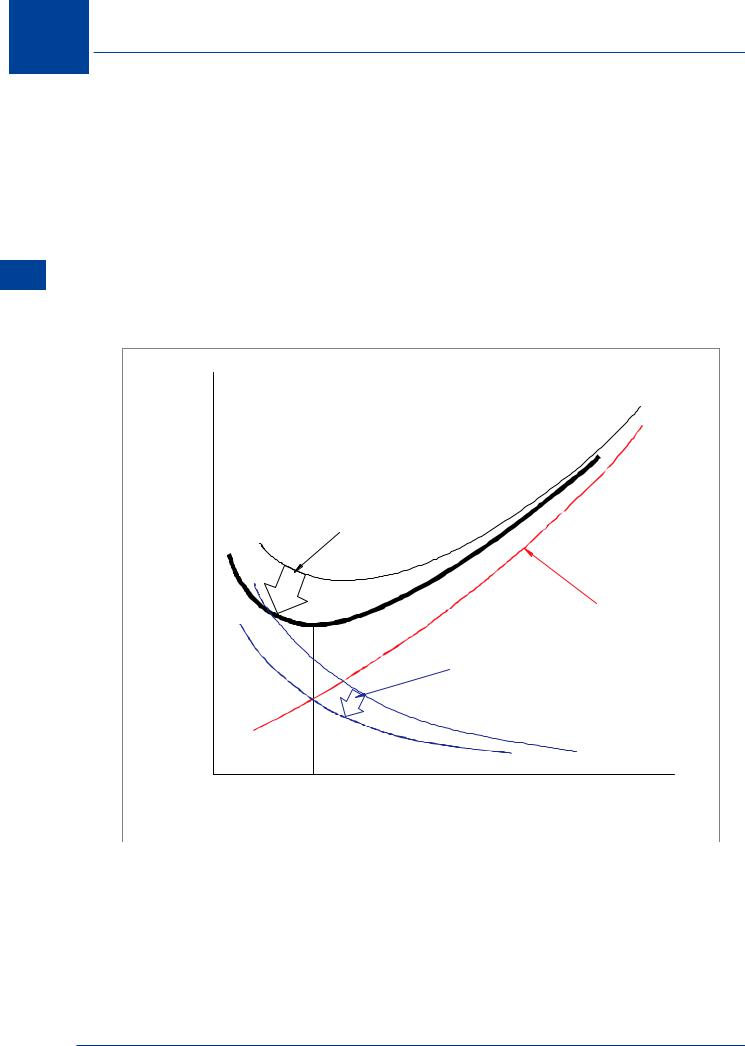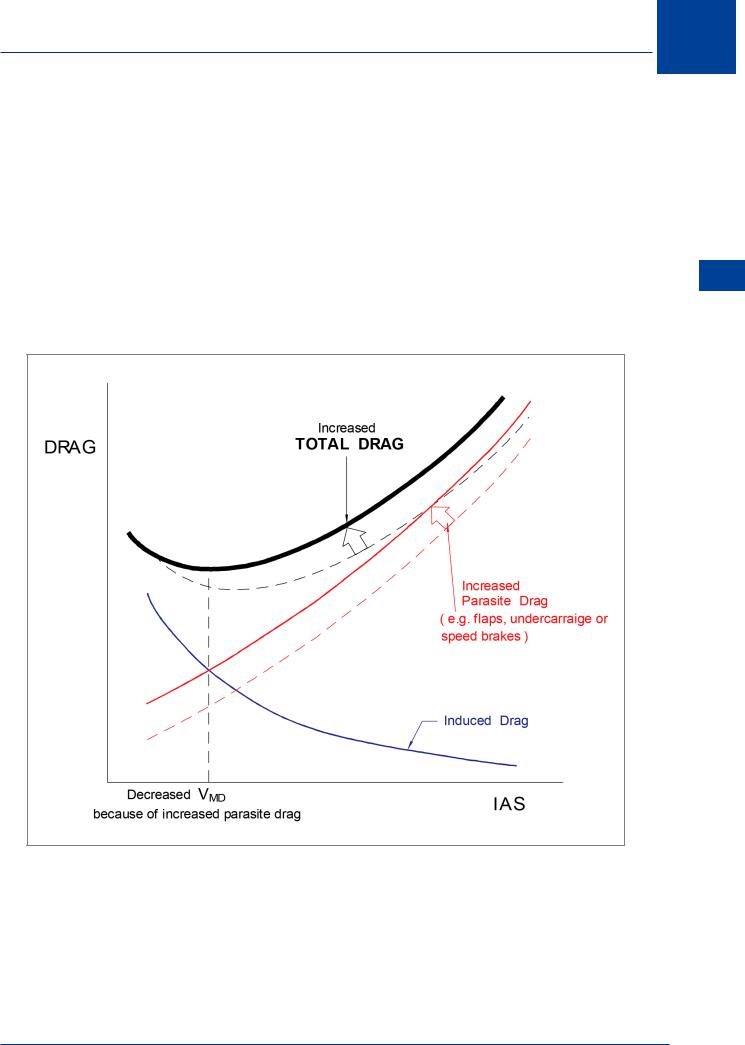
- •Textbook Series
- •Contents
- •1 Overview and Definitions
- •Overview
- •General Definitions
- •Glossary
- •List of Symbols
- •Greek Symbols
- •Others
- •Self-assessment Questions
- •Answers
- •2 The Atmosphere
- •Introduction
- •The Physical Properties of Air
- •Static Pressure
- •Temperature
- •Air Density
- •International Standard Atmosphere (ISA)
- •Dynamic Pressure
- •Key Facts
- •Measuring Dynamic Pressure
- •Relationships between Airspeeds
- •Airspeed
- •Errors and Corrections
- •V Speeds
- •Summary
- •Questions
- •Answers
- •3 Basic Aerodynamic Theory
- •The Principle of Continuity
- •Bernoulli’s Theorem
- •Streamlines and the Streamtube
- •Summary
- •Questions
- •Answers
- •4 Subsonic Airflow
- •Aerofoil Terminology
- •Basics about Airflow
- •Two Dimensional Airflow
- •Summary
- •Questions
- •Answers
- •5 Lift
- •Aerodynamic Force Coefficient
- •The Basic Lift Equation
- •Review:
- •The Lift Curve
- •Interpretation of the Lift Curve
- •Density Altitude
- •Aerofoil Section Lift Characteristics
- •Introduction to Drag Characteristics
- •Lift/Drag Ratio
- •Effect of Aircraft Weight on Minimum Flight Speed
- •Condition of the Surface
- •Flight at High Lift Conditions
- •Three Dimensional Airflow
- •Wing Terminology
- •Wing Tip Vortices
- •Wake Turbulence: (Ref: AIC P 072/2010)
- •Ground Effect
- •Conclusion
- •Summary
- •Answers from page 77
- •Answers from page 78
- •Questions
- •Answers
- •6 Drag
- •Introduction
- •Parasite Drag
- •Induced Drag
- •Methods of Reducing Induced Drag
- •Effect of Lift on Parasite Drag
- •Aeroplane Total Drag
- •The Effect of Aircraft Gross Weight on Total Drag
- •The Effect of Altitude on Total Drag
- •The Effect of Configuration on Total Drag
- •Speed Stability
- •Power Required (Introduction)
- •Summary
- •Questions
- •Annex C
- •Answers
- •7 Stalling
- •Introduction
- •Cause of the Stall
- •The Lift Curve
- •Stall Recovery
- •Aircraft Behaviour Close to the Stall
- •Use of Flight Controls Close to the Stall
- •Stall Recognition
- •Stall Speed
- •Stall Warning
- •Artificial Stall Warning Devices
- •Basic Stall Requirements (EASA and FAR)
- •Wing Design Characteristics
- •The Effect of Aerofoil Section
- •The Effect of Wing Planform
- •Key Facts 1
- •Super Stall (Deep Stall)
- •Factors that Affect Stall Speed
- •1g Stall Speed
- •Effect of Weight Change on Stall Speed
- •Composition and Resolution of Forces
- •Using Trigonometry to Resolve Forces
- •Lift Increase in a Level Turn
- •Effect of Load Factor on Stall Speed
- •Effect of High Lift Devices on Stall Speed
- •Effect of CG Position on Stall Speed
- •Effect of Landing Gear on the Stall Speed
- •Effect of Engine Power on Stall Speed
- •Effect of Mach Number (Compressibility) on Stall Speed
- •Effect of Wing Contamination on Stall Speed
- •Warning to the Pilot of Icing-induced Stalls
- •Stabilizer Stall Due to Ice
- •Effect of Heavy Rain on Stall Speed
- •Stall and Recovery Characteristics of Canards
- •Spinning
- •Primary Causes of a Spin
- •Phases of a Spin
- •The Effect of Mass and Balance on Spins
- •Spin Recovery
- •Special Phenomena of Stall
- •High Speed Buffet (Shock Stall)
- •Answers to Questions on Page 173
- •Key Facts 2
- •Questions
- •Key Facts 1 (Completed)
- •Key Facts 2 (Completed)
- •Answers
- •8 High Lift Devices
- •Purpose of High Lift Devices
- •Take-off and Landing Speeds
- •Augmentation
- •Flaps
- •Trailing Edge Flaps
- •Plain Flap
- •Split Flap
- •Slotted and Multiple Slotted Flaps
- •The Fowler Flap
- •Comparison of Trailing Edge Flaps
- •and Stalling Angle
- •Drag
- •Lift / Drag Ratio
- •Pitching Moment
- •Centre of Pressure Movement
- •Change of Downwash
- •Overall Pitch Change
- •Aircraft Attitude with Flaps Lowered
- •Leading Edge High Lift Devices
- •Leading Edge Flaps
- •Effect of Leading Edge Flaps on Lift
- •Leading Edge Slots
- •Leading Edge Slat
- •Automatic Slots
- •Disadvantages of the Slot
- •Drag and Pitching Moment of Leading Edge Devices
- •Trailing Edge Plus Leading Edge Devices
- •Sequence of Operation
- •Asymmetry of High Lift Devices
- •Flap Load Relief System
- •Choice of Flap Setting for Take-off, Climb and Landing
- •Management of High Lift Devices
- •Flap Extension Prior to Landing
- •Questions
- •Annexes
- •Answers
- •9 Airframe Contamination
- •Introduction
- •Types of Contamination
- •Effect of Frost and Ice on the Aircraft
- •Effect on Instruments
- •Effect on Controls
- •Water Contamination
- •Airframe Aging
- •Questions
- •Answers
- •10 Stability and Control
- •Introduction
- •Static Stability
- •Aeroplane Reference Axes
- •Static Longitudinal Stability
- •Neutral Point
- •Static Margin
- •Trim and Controllability
- •Key Facts 1
- •Graphic Presentation of Static Longitudinal Stability
- •Contribution of the Component Surfaces
- •Power-off Stability
- •Effect of CG Position
- •Power Effects
- •High Lift Devices
- •Control Force Stability
- •Manoeuvre Stability
- •Stick Force Per ‘g’
- •Tailoring Control Forces
- •Longitudinal Control
- •Manoeuvring Control Requirement
- •Take-off Control Requirement
- •Landing Control Requirement
- •Dynamic Stability
- •Longitudinal Dynamic Stability
- •Long Period Oscillation (Phugoid)
- •Short Period Oscillation
- •Directional Stability and Control
- •Sideslip Angle
- •Static Directional Stability
- •Contribution of the Aeroplane Components.
- •Lateral Stability and Control
- •Static Lateral Stability
- •Contribution of the Aeroplane Components
- •Lateral Dynamic Effects
- •Spiral Divergence
- •Dutch Roll
- •Pilot Induced Oscillation (PIO)
- •High Mach Numbers
- •Mach Trim
- •Key Facts 2
- •Summary
- •Questions
- •Key Facts 1 (Completed)
- •Key Facts 2 (Completed)
- •Answers
- •11 Controls
- •Introduction
- •Hinge Moments
- •Control Balancing
- •Mass Balance
- •Longitudinal Control
- •Lateral Control
- •Speed Brakes
- •Directional Control
- •Secondary Effects of Controls
- •Trimming
- •Questions
- •Answers
- •12 Flight Mechanics
- •Introduction
- •Straight Horizontal Steady Flight
- •Tailplane and Elevator
- •Balance of Forces
- •Straight Steady Climb
- •Climb Angle
- •Effect of Weight, Altitude and Temperature.
- •Power-on Descent
- •Emergency Descent
- •Glide
- •Rate of Descent in the Glide
- •Turning
- •Flight with Asymmetric Thrust
- •Summary of Minimum Control Speeds
- •Questions
- •Answers
- •13 High Speed Flight
- •Introduction
- •Speed of Sound
- •Mach Number
- •Effect on Mach Number of Climbing at a Constant IAS
- •Variation of TAS with Altitude at a Constant Mach Number
- •Influence of Temperature on Mach Number at a Constant Flight Level and IAS
- •Subdivisions of Aerodynamic Flow
- •Propagation of Pressure Waves
- •Normal Shock Waves
- •Critical Mach Number
- •Pressure Distribution at Transonic Mach Numbers
- •Properties of a Normal Shock Wave
- •Oblique Shock Waves
- •Effects of Shock Wave Formation
- •Buffet
- •Factors Which Affect the Buffet Boundaries
- •The Buffet Margin
- •Use of the Buffet Onset Chart
- •Delaying or Reducing the Effects of Compressibility
- •Aerodynamic Heating
- •Mach Angle
- •Mach Cone
- •Area (Zone) of Influence
- •Bow Wave
- •Expansion Waves
- •Sonic Bang
- •Methods of Improving Control at Transonic Speeds
- •Questions
- •Answers
- •14 Limitations
- •Operating Limit Speeds
- •Loads and Safety Factors
- •Loads on the Structure
- •Load Factor
- •Boundary
- •Design Manoeuvring Speed, V
- •Effect of Altitude on V
- •Effect of Aircraft Weight on V
- •Design Cruising Speed V
- •Design Dive Speed V
- •Negative Load Factors
- •The Negative Stall
- •Manoeuvre Boundaries
- •Operational Speed Limits
- •Gust Loads
- •Effect of a Vertical Gust on the Load Factor
- •Effect of the Gust on Stalling
- •Operational Rough-air Speed (V
- •Landing Gear Speed Limitations
- •Flap Speed Limit
- •Aeroelasticity (Aeroelastic Coupling)
- •Flutter
- •Control Surface Flutter
- •Aileron Reversal
- •Questions
- •Answers
- •15 Windshear
- •Introduction (Ref: AIC 84/2008)
- •Microburst
- •Windshear Encounter during Approach
- •Effects of Windshear
- •“Typical” Recovery from Windshear
- •Windshear Reporting
- •Visual Clues
- •Conclusions
- •Questions
- •Answers
- •16 Propellers
- •Introduction
- •Definitions
- •Aerodynamic Forces on the Propeller
- •Thrust
- •Centrifugal Twisting Moment (CTM)
- •Propeller Efficiency
- •Variable Pitch Propellers
- •Power Absorption
- •Moments and Forces Generated by a Propeller
- •Effect of Atmospheric Conditions
- •Questions
- •Answers
- •17 Revision Questions
- •Questions
- •Answers
- •Explanations to Specimen Questions
- •Specimen Examination Paper
- •Answers to Specimen Exam Paper
- •Explanations to Specimen Exam Paper
- •18 Index

6 Drag
Drag 6
The Effect of Aircraft Gross Weight on Total Drag
The effect of variation in aircraft gross weight on total drag can be seen from Figure 6.18. As fuel is consumed, gross weight will decrease. As the aircraft weight decreases, less lift is required (lower CL) which will reduce induced drag. Total drag will be less and VMD will occur at a lower IAS.
If an aircraft is operated at a higher gross weight, more lift will be required. If more lift is generated, induced drag will be higher, total drag will be greater and VMD will occur at a higher IAS. If an aircraft is manoeuvred so that the load factor is increased, the result will be similar to that caused by an increase in gross weight, i.e. induced drag will increase.
DRAG |
|
Decreased |
|
TOTAL DRAG |
|
at lower weight |
|
|
Parasite Drag |
Less |
|
Induced |
Drag |
at lower weight |
|
Decreased VMD |
IAS |
because of lower weight |
|
|
|
|
Figure 6.18 |
126

Drag 6
The Effect of Altitude on Total Drag
Aircraft usually operate within limits of Indicated Airspeed (IAS), so it is relevant to consider the variation of drag with IAS. If an aircraft is flown at a constant IAS, dynamic pressure will be constant. As density decreases with increasing altitude, TAS must be increased to maintain the constant IAS (Q = ½ ρ V2 ). If the aircraft is flown at a constant IAS, drag will not vary with altitude.
The Effect of Configuration on Total Drag
Extension of the landing gear, air brakes, or flaps will increase parasite drag but will not substantially affect induced drag. The effect of increasing parasite drag is to increase total drag at any IAS but to decrease the speed VMD compared to the clean aircraft, (Figure 6.19).
Figure 6.19
Drag 6
127

6 Drag
Drag 6
Speed Stability
For an aircraft to be in steady flight, the aircraft must be in equilibrium - there can be no out of balance forces or moments. When an aircraft is trimmed to fly at a steady speed, thrust and drag are equal. Therefore, when an aircraft is in steady flight it can be said that the term DRAG and the term ‘THRUST REQUIRED’ have the same meaning.
Consequently, an alternative to considering DRAG against IAS as in the graph of Figure 6.16, the term ‘THRUST REQUIRED’ can be substituted for drag.
For an aircraft in steady flight, if there is a variation in speed with no change in throttle setting, (which is called ‘THRUST AVAILABLE’), depending on the trim speed, there will be either an excess or a deficiency of thrust available. This phenomena is illustrated in Figure 6.20.
DRAG |
|
|
Thrust |
or |
|
|
|
Thrust |
|
|
Excess |
|
|
Thrust |
|
Required |
Thrust |
Thrust |
Deficiency |
|
Deficiency |
Available |
|
|
Thrust |
|
A |
|
Excess |
|
|
|
B |
|
|
|
Non |
|
|
|
Stable |
|
|
|
IAS |
|
Stable IAS region |
|
Region |
|
|
|
VMD |
|
IAS |
|
Neutral |
|
|
|
|
|
|
|
IAS |
|
|
|
Region |
|
|
Figure 6.20
128

Drag 6
If an aircraft is established in steady flight at point ‘A’ in Figure 6.20, lift is equal to weight and the thrust available is set to match the thrust required. If the aircraft is disturbed to some airspeed slightly greater than point ‘A’, a thrust deficiency will exist and, if the aircraft is disturbed to some airspeed slightly lower than point ‘A’, a thrust excess will exist. This relationship provides a tendency for the aircraft to return to the equilibrium of point ‘A’ and resume the original trim speed. Steady flight at speeds greater than VMD is characterized by a relatively strong tendency of the aircraft to maintain the trim speed quite naturally; the aircraft is speed stable.
Speed stability is an important consideration, particularly at speeds at and below VMD, most often encountered during the approach to landing phase of flight.
If an aircraft is established in steady flight at point ‘B’ in Figure 6.20, lift is equal to weight and the thrust available is set to match the thrust required. If the aircraft is disturbed and goes faster than the trim speed, there will be a decrease in drag giving an excess of thrust which will cause the aircraft to accelerate. If a disturbance slows the aircraft below the trim speed, there will be an increase in drag which will give a thrust deficiency causing the aircraft to slow further. This relationship is basically unstable because the variation of excess thrust to either side of point ‘B’ tends to magnify any original disturbance. Steady flight at speeds less than VMD is characterized by a tendency for the aircraft to drift away from the trim speed and the aircraft is speed unstable. If a disturbance reduces speed, it will naturally continue to reduce. If a disturbance increases speed, it will continue to accelerate until the thrust and drag are once more balanced. For this reason, the pilot must closely monitor IAS during the approach phase of flight. Any tendency for the aircraft to slow down must be countered immediately by a ‘generous’ application of thrust to quickly return to the desired trim speed.
Consider Figure 6.19. If an aircraft maintains a constant IAS in the speed unstable region, the addition of parasite drag by selecting undercarriage down or by deploying flaps has the benefit of reducing VMD which can improve speed stability by moving the speed stable region to the left.
At speeds very close to VMD an aircraft usually exhibits no tendency towards either speed stability or speed instability - the neutral IAS region.
Drag 6
129
